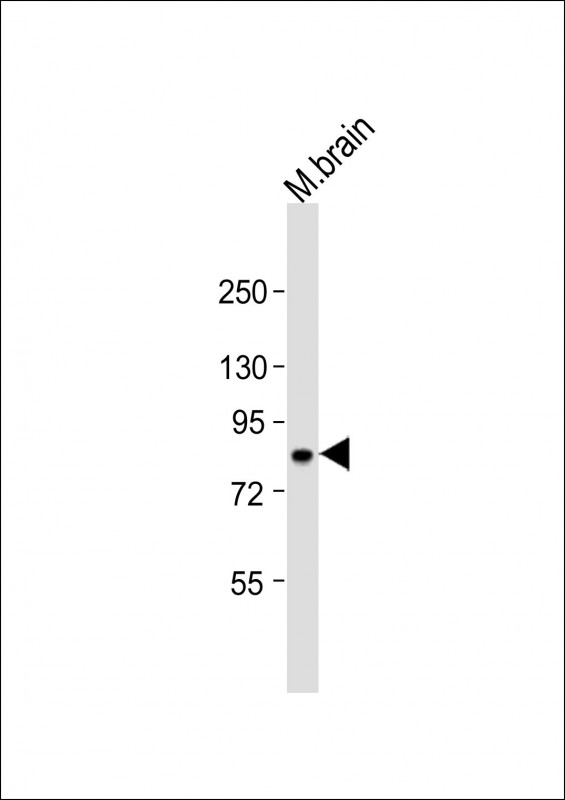
| WB | 1/2000 | Human,Mouse,Rat |
| IF | 咨询技术 | Human,Mouse,Rat |
| IHC | 咨询技术 | Human,Mouse,Rat |
| ICC | 技术咨询 | Human,Mouse,Rat |
| FCM | 咨询技术 | Human,Mouse,Rat |
| Elisa | 咨询技术 | Human,Mouse,Rat |
| Aliases | Lethal(3)malignant brain tumor-like protein 1, H-l(3)mbt, H-l(3)mbt protein, L(3)mbt-like, L(3)mbt protein homolog, L3MBTL1, L3MBTL1, KIAA0681, L3MBT, L3MBTL |
| Entrez GeneID | 26013 |
| WB Predicted band size | 92.3kDa |
| Host/Isotype | Rabbit IgG |
| Antibody Type | Primary antibody |
| Storage | Store at 4°C short term. Aliquot and store at -20°C long term. Avoid freeze/thaw cycles. |
| Species Reactivity | Human, Mouse, Rat |
| Immunogen | This L3MBTL1 antibody is generated from a rabbit immunized with a KLH conjugated synthetic peptide between 451-485 amino acids from the Central region of human L3MBTL1. |
+ +
以下是关于L3MBTL1抗体的3篇参考文献及其摘要内容:
---
1. **文献名称**: *"L3MBTL1 recognition of mono- and trimethylated histones"*
**作者**: Trojer, P., et al.
**摘要**: 该研究阐明了L3MBTL1通过其MBT结构域选择性识别单甲基化和三甲基化组蛋白标记(如H4K20me1/me3),并介导染色质压缩以抑制基因转录。文中开发了特异性L3MBTL1抗体,用于染色质免疫沉淀(ChIP)分析其在基因组的定位。
2. **文献名称**: *"L3MBTL1 interacts with the SIN3-HDAC complex to regulate transcription"*
**作者**: Boccuni, P., et al.
**摘要**: 研究发现L3MBTL1与SIN3-HDAC转录抑制复合物相互作用,参与细胞周期调控。通过Western blot和免疫荧光实验,使用L3MBTL1抗体证实其在多种癌细胞系中的核内定位及表达水平变化。
3. **文献名称**: *"A role for L3MBTL1 in DNA repair and genomic stability"*
**作者**: Qin, J., et al.
**摘要**: 该文献揭示了L3MBTL1通过结合DNA损伤位点调控同源重组修复。研究利用特异性抗体进行免疫共沉淀(Co-IP),证明其与RAD51等修复蛋白的相互作用,提示L3MBTL1在维持基因组稳定性中的功能。
---
这些文献均涉及L3MBTL1抗体的实验应用,涵盖染色质定位、蛋白互作及功能机制研究。如需具体文献链接或补充信息,可进一步通过PubMed或期刊官网检索。
L3MBTL1 (Lethal(3)malignant brain tumor-like 1) is a chromatin-associated protein belonging to the Polycomb group (PcG) family, which plays a critical role in epigenetic gene regulation. It contains multiple MBT (malignant brain tumor) domains that recognize methylated lysine residues on histones, particularly H4K20me1/2 and H1bK26me1. facilitating chromatin compaction and transcriptional repression. L3MBTL1 functions as a reader of histone methylation marks, recruiting corepressor complexes like the Polycomb repressive complex 1 (PRC1) to maintain gene silencing, regulate genome stability, and influence cellular processes such as DNA repair and cell cycle progression.
Antibodies targeting L3MBTL1 are essential tools for studying its localization, interactions, and role in chromatin biology. They are widely used in techniques like immunoprecipitation (IP), Western blotting, immunofluorescence, and chromatin immunoprecipitation (ChIP) to investigate its association with repressive chromatin domains or specific genomic loci. Commercial L3MBTL1 antibodies are typically raised against epitopes within its N-terminal region or MBT domains. Validation often includes knockout cell lines or peptide competition assays to confirm specificity. Some antibodies distinguish between post-translationally modified forms, aiding in functional studies.
Dysregulation of L3MBTL1 has been linked to cancers, including leukemia and solid tumors, where it may act as a tumor suppressor or oncogene depending on context. Its antibodies enable research into disease mechanisms, such as aberrant chromatin remodeling or mislocalization in malignancies. Additionally, they help explore crosstalk between Polycomb proteins and other epigenetic regulators, providing insights into therapeutic targeting of epigenetic pathways.
×